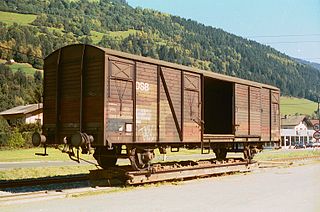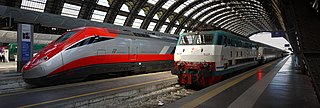
A transporter wagon, in railway terminology, is a wagon (UIC) or railroad car (US) designed to carry other railway equipment. Normally, it is used to transport equipment of a different rail gauge. In most cases, a transporter wagon is a narrower gauge wagon for transporting a wider gauge equipment, allowing freight in a wider gauge wagons to reach destinations on the narrower gauge network without the expense and time of transshipment into a narrower gauge wagons.

The Italian railway system is one of the most important parts of the infrastructure of Italy, with a total length of 24,567 km (15,265 mi) of which active lines are 16,832 km (10,459 mi). The network has recently grown with the construction of the new high-speed rail network. Italy is a member of the International Union of Railways (UIC). The UIC Country Code for Italy is 83.

The Hellenic Railways Organisation or OSE is the Greek national railway company which owns, maintains and operates all railway infrastructure in Greece with the exception of Athens' rapid transit lines. Train services on these lines are run by Hellenic Train S.A., a former OSE subsidiary, Rail Cargo Logistics Goldair, Pearl and Grup Feroviar Român.

Tinsley was a railway marshalling yard near Tinsley in Sheffield, England, used to separate railway wagons from incoming trains and add them to new trains. It was sited immediately west of the M1 motorway, about one mile north of the Catcliffe junction. It was opened in 1965, as a part of a major plan to rationalise all aspects of the rail services in the Sheffield area; it closed in stages from 1985, with the run-down of rail freight in Britain. It was also the site of Tinsley Traction Maintenance Depot (TMD), which was closed in 1998; at its peak, 200 locomotives were allocated to this depot.

The Italian railway system is one of the most important parts of the infrastructure of Italy, with a total length of 24,227 km (15,054 mi) as of 2011.

Rail transport in Montenegro is operated by four separate companies, which independently handle railway infrastructure, passenger transport, cargo transport and maintenance of the rolling stock. The four companies were a part of public company Railways of Montenegro until it was split up in 2008.

The Milan–Bologna high-speed railway is a railway line that links the cities of Milan and Bologna, part of the Italian high-speed rail network. It runs parallel to the historical north–south railway between Milan and Bologna, which itself follows the ancient Roman Road, the Via Aemilia. The new railway follows the Autostrada A1 closely for much of its length. The new line allows faster traffic to run separated and increase the overall railway capacity between the two cities.

The Milan–Bologna railway is the northern part of the traditional main north–south trunk line of the Italian railway network. It closely follows the ancient Roman Road, the Via Aemilia. The line was opened between 1859 and 1861 as a single-line railway, and was doubled between 1866 and 1894. It was electrified at 3,000 volts DC in 1938. High-speed trains on the route have used the parallel Milan–Bologna high-speed line since 13 December 2008.

Pisa Centrale railway station is the central station of the Italian city of Pisa, the first station of the city in terms of passengers, before Pisa San Rossore railway station. The station is one of the major railway junctions of Tuscany. Lines serving the station include three long-distance lines: the Pisa–Livorno–Rome line, the Pisa–La Spezia–Genoa line and the Pisa–Florence line. Local services operate on the Lucca–Pisa line. The line from Pisa to Vada via Collesalvetti, which was closed from 1992 to 2000, is now only open for freight traffic.

The Verona–Bologna railway is a major Italian railway connecting Verona and Bologna and part of the major axis from the Brenner railway to the Bologna–Florence and on to Rome. The line is part of the Line 1 of Trans-European Transport Networks (TEN-T). It is considered a "fundamental" line by the state railways Ferrovie dello Stato (FS).

Verona Porta Nuova is the main railway station of Verona, Italy. It is one of the two stations serving central Verona; the other station, Verona Porta Vescovo, is located at the east of the city.

Treviso Centrale railway station serves the city and comune of Treviso, in the Veneto region, northeastern Italy. Opened in 1851, the station forms part of the Venice–Udine railway, and is also a junction of three branch lines, to Montebelluna, Vicenza and Portogruaro, respectively.

Padova railway station, or Padua railway station, sometimes referred to as Padova Centrale, is the main station serving the city and comune of Padua, in the Veneto region, northeastern Italy.

Como San Giovanni railway station is the main station serving the city and comune of Como, in the region of Lombardy, northern Italy. Opened in 1875, it forms part of the Milan–Chiasso railway, and is also a terminus of the Como–Lecco railway, which branches off the main line a few kilometres (miles) to the south, at Albate-Camerlata.

Faenza railway station serves the city and comune of Faenza, in the region of Emilia-Romagna, northern Italy. Opened in 1893, it forms part of the Bologna–Ancona railway, and is also a terminus of two secondary railways, linking Faenza with Lavezzola and with Ravenna, and with Florence, respectively.

Catanzaro Lido railway station is one of the railway stations serving the city and comune of Catanzaro, capital of the Calabria region, southern Italy. Opened in 1875, it forms part of the Jonica railway, and is also a terminus of a secondary line, the Lamezia Terme–Catanzaro Lido railway.
Villa San Giovanni railway station is the main railway station serving the town and comune of Villa San Giovanni, in the region of Calabria, southern Italy. It opened in 1884, and it forms part of the Battipaglia–Reggio di Calabria railway.

The Salerno–Reggio Calabria railway is the most important north–south railway connection between Sicily, Calabria and the rest of the Italian peninsula. It forms the southern section of Corridor 1 of the European Union's Trans-European high-speed rail network, which connects Berlin and Palermo. Its southern part, between Rosarno and San Lucido is also used as an RFI freight route between the Port of Gioia Tauro and the Adriatic railway.

Mirandola railway station is a railway stop along the Verona-Bologna railway serving the city of Mirandola, in the province of Modena, in Emilia-Romagna, Italy. The station serves also the municipalities of Medolla, Cavezzo, San Possidonio, and Finale Emilia. Located in the village of Cividale, about 3 km from the town centre of Mirandola, th station is connected by a SETA shuttle bus.

















